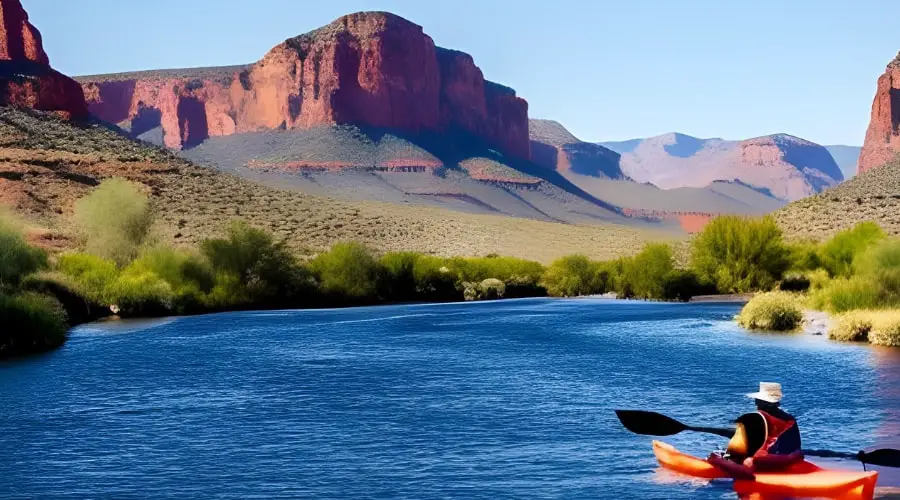The Salt River, located in Arizona, offers a perfect opportunity to connect with nature while kayaking through its picturesque landscapes. The river provides various sections suitable for different skill levels and boasts an abundance of wildlife. This article will guide you through everything you need to know about kayaking the Salt River.

Essential Kayaking Gear
Before embarking on your Salt River kayaking adventure, make sure you have the right gear:
Kayak
Choose a kayak suitable for river use. A sit-on-top or recreational kayak is perfect for beginners, while more experienced kayakers may prefer a touring or whitewater kayak.
Paddle
Select a paddle that suits your height and paddling style. A lightweight paddle can reduce fatigue during long trips.
Personal Floatation Device (PFD)
Always wear a properly fitted PFD to ensure your safety on the water.
Spray Skirt and Dry Bags
A spray skirt can help keep water out of your kayak, while dry bags protect your belongings from getting wet.
How to Choose the Right Kayak
When selecting a kayak for your Salt River adventure, consider factors such as your skill level, the river’s conditions, and your personal preferences. Beginners should opt for a stable and forgiving kayak, while more advanced paddlers might prefer a nimble and responsive model.
Paddling Techniques
To kayak efficiently, you’ll need to master basic paddling techniques:
Forward Stroke
The forward stroke propels your kayak straight ahead. To execute it, reach forward with your paddle, submerge the blade in the water, and pull it back to your hip.
Sweep Stroke
The sweep stroke helps you turn your kayak. To perform it, place the paddle in the water near your feet and sweep it outward in a wide arc.
Reverse Stroke
The reverse stroke slows or stops your kayak. Reach behind you, submerge the paddle, and pull it forward towards your feet.
Navigating the Salt River
When planning your kayaking trip on the Salt River, consider the following:
Popular Access Points
Some common access points include Water Users Recreation Site, Blue Point, and Goldfield.
River Sections and Difficulty
The river’s difficulty varies depending on the section. The Lower Salt River is ideal for beginners, while the Upper Salt River provides challenging rapids for experienced kayakers.
Safety Tips for Kayaking the Salt River
Ensure a safe and enjoyable trip by following these safety guidelines:
- Always wear a PFD.
- Check weather and river conditions before your trip.
- Let someone know your planned route and expected return time.
- Stay hydrated and bring snacks.
- Carry a first-aid kit, a whistle, and a communication device.
Wildlife and Scenery
The Salt River is home to an array of wildlife, including wild horses, bald eagles, and great blue herons. While enjoying these majestic creatures, remember to observe from a safe distance and avoid disturbing their habitat.
The river’s breathtaking scenery includes stunning canyons, lush vegetation, and striking rock formations. Be sure to take breaks and soak in the natural beauty around you.
When to Kayak the Salt River
The ideal time to kayak the Salt River is between April and October when water levels are typically higher, and the weather is warmer. However, always check the river conditions before your trip to ensure a safe and enjoyable experience.
Permits and Regulations
To kayak the Salt River, you’ll need a Tonto Daily Pass or a Tonto Discovery Pass. Additionally, follow Leave No Trace principles, such as disposing of waste properly and respecting wildlife.
Guided Tours and Rentals
For those unfamiliar with the Salt River or kayaking in general, guided tours and kayak rentals are available. These options provide a hassle-free way to explore the river and learn about its unique environment.
Related: 5 Basic Tips for Kayaking
Frequently Asked Questions:
What kind of wildlife can I expect to see while kayaking the Salt River?
You may spot wild horses, bald eagles, great blue herons, and various other bird species along the river.
Do I need a permit to kayak the Salt River?
Yes, you’ll need a Tonto Daily Pass or a Tonto Discovery Pass to access the river.
What type of kayak is best for the Salt River?
A sit-on-top or recreational kayak is ideal for beginners, while experienced kayakers might prefer a touring or whitewater kayak.
What should I bring on my Salt River kayaking trip?
Bring essential gear like a kayak, paddle, PFD, spray skirt, and dry bags. Additionally, pack water, snacks, sunscreen, a hat, and a first-aid kit.
When is the best time to kayak the Salt River?
The prime kayaking season on the Salt River is between April and October. Always check river conditions before your trip.
Conclusion
Kayaking the Salt River offers an unforgettable experience amidst Arizona’s stunning landscapes and diverse wildlife. By following the guidelines in this article, you’ll be well-prepared for a safe and enjoyable paddling adventure.
